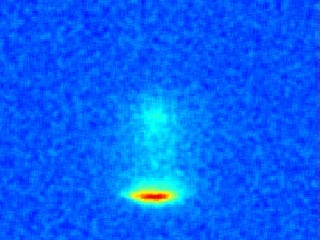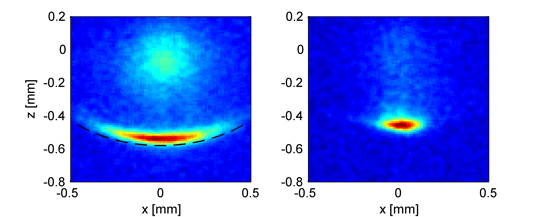Laser Cooling Erbium to Ultracold Temperatures
To develop the ability to fabricate nanoscale optical devices with the magneto-optical trap (MOT) ion source,
we have developed a variety of methods for erbium laser cooling. Most recently, we cooled these atoms to extremely
low temperatures with a novel "narrow-line" MOT relying on erbium’s unique magneto-optical properties.
To bring Er to ultracold, few microkelvin, temperatures, we cool it on the 841 nm transition (Γ/2π = 8kHz)
transition, where the narrow linewidth should allow cooling to temperatures as low as the Doppler temperature of 200 nK. Unfortunately, in a conventional
MOT using this narrow transition, magnetic forces are strong enough to tear the trap apart. To overcome this difficulty, we developed a method for
balancing magnetic and optical forces in a novel "strongly magnetic" narrow-line MOT, achieving stable trapping and cooling to temperatures of
1 µK or 2 µK.
|
Fluorescence images of narrow-line MOTs are shown in Fig. 1. On the left side, a single, downward-propagating, blue-detuned laser pushes atoms out of the magnetic trap (top of image) and into a narrow sheet where atoms feel equal and opposite optical and magnetic forces. On the right, atoms are cooled by lasers propagating in all directions. Atoms in these traps reach temperatures as low as 1 µK. This "strongly-magnetic MOT" has a number of unusual features, which contrast with conventional MOTs. Some of these are summarized in Table 1.
| Convention MOT | Strongly Magnetic MOT | |
|---|---|---|
| Trap beam detuning | Red | Blue |
| B field at trap position | 0 | ≠0 |
| Spin polarization | Unpolarized | Fully polarized |
| Confinement force | Optical | Optical + magnetic |
One of the most striking features of this trap is the fact that atoms are spin-polarized in a weak-field seeking state at a position of non-zero magnetic field. To demonstrate this, we can shut off the trap lasers but leave the magnetic fields on. In this case, we expect atoms to move towards the origin and oscillate in the linear potential of the magnetic quadrupole field. The results of such an experiment are shown in the movie linked from the figure below.

Figure 2. Er atoms in a narrow-line MOT are released into a purely magnetic trap at time t=0.
Video of this is available; click here or on Figure 2 image above for the video clip. The video spans 100 ms of real
time. Eventually, the anharmonic nature of the magnetic potential leads to complicated cloverleaf trajectories.
Note: There is no audio in the video. Media player software is needed to open the file.
Several media players are available for free download.
Narrow-Line Magnetic-Optical Cooling and Trapping of Strongly Magnetic Atoms
Andrew Berglund - NIST
Jabez J. McClelland - NIST
James Hanssen - University of Maryland
Online: March 2008
Last Updated: April 2008
Website Comments:egpwebmaster@nist.gov

